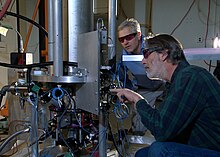
Summary
NIST-F2 is a caesium fountain atomic clock that, along with NIST-F1, serves as the United States' primary time and frequency standard.[1] NIST-F2 was brought online on 3 April 2014.[1][2]

Accuracy edit
NIST-F1, a cesium fountain atomic clock used since 1999, has a fractional inaccuracy (δf / f) of less than 5×10−16.
The planned performance of NIST-F2 is δf / f < 1×10−16.[3] At this planned performance level the NIST-F2 clock will not lose a second in at least 300 million years.[4]
Evaluated accuracy edit
The evaluated accuracy (uB) reports of various primary frequency and time standards are published online by the International Bureau of Weights and Measures (BIPM). The first in-house accuracy evaluation of NIST-F2 reported a uB of 1.1 × 10−16.[5] In March 2014 and March 2015 the NIST-F2 cesium fountain clock reported a uB of 1.5 × 10−16 in the BIPM reports of evaluation of primary frequency standards.
The last submission of NIST-F1 to BIPM TAI was February 2016.[6]
At the request of the Italian standards organization, NIST manufactured many duplicate components for a second version of NIST-F2, known as IT-CsF2 to be operated by the Istituto Nazionale di Ricerca Metrologica (INRiM), NIST's counterpart in Turin, Italy.[1] As of February 2016 the IT-CsF2 cesium fountain clock started reporting a uB of 1.7 × 10−16 in the BIPM reports of evaluation of primary frequency standards.[7][8]
References edit
- ^ a b c NIST Launches a New U.S. Time Standard: NIST-F2 Atomic Clock
- ^ First Accuracy Evaluation of NIST-F2, T. P. Heavner, S. R. Jefferts, J. H. Shirley, T. E. Parker, E. A. Donley, N. Ashby, S. Barlow, F. Levi, and G. Costanzo, May 2014
- ^ Jefferts, Steven R.; Heavner, Thomas P.; Parker, Thomas E.; Shirley, Jon H. (September 2007). NIST Cesium Fountains — Current Status and Future Prospects (PDF). International School and Conference on Optics and Optical Materials, ISCOM07. Acta Physica Polonica A. Vol. 112, no. 5. Belgrade, Serbia. pp. 759–767. doi:10.1117/12.734965. Also available from NIST directly.
- ^ "Time gets an upgrade". New Scientist. 12 April 2014. p. 7.
- ^ Heavner T P, Donley E A , Levi F, Costanzo G, Parker TE, Shirley J H, Ashby N, Barlow S and Jefferts SR, “First accuracy evaluation of NIST-F2,” 2014 Metrologia 51, 174–182, May 2014
- ^ "BIPM - Time Department FTP server". www.bipm.org. Retrieved 2019-03-22.
- ^ February 2016 IT-CsF2 TAI evaluation
- ^ June 2018 IT-CsF2 TAI evaluation
External links edit
- NIST Time and Frequency Div. — 2004: Strategic Focus 1 (National Institute of Standards and Technology)
- "NIST Launches a New U.S. Time Standard: NIST-F2 Atomic Clock" on YouTube
- "Time gets an upgrade". newscientist.com. New Scientist. Retrieved 27 February 2018.


